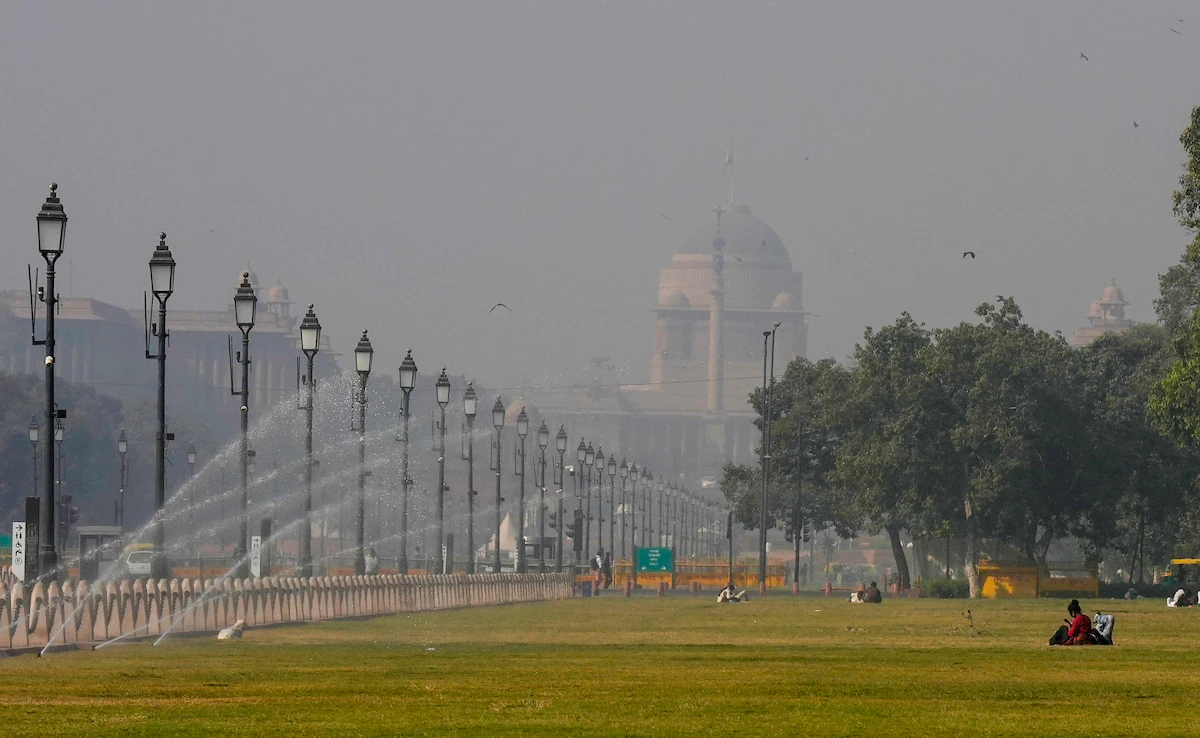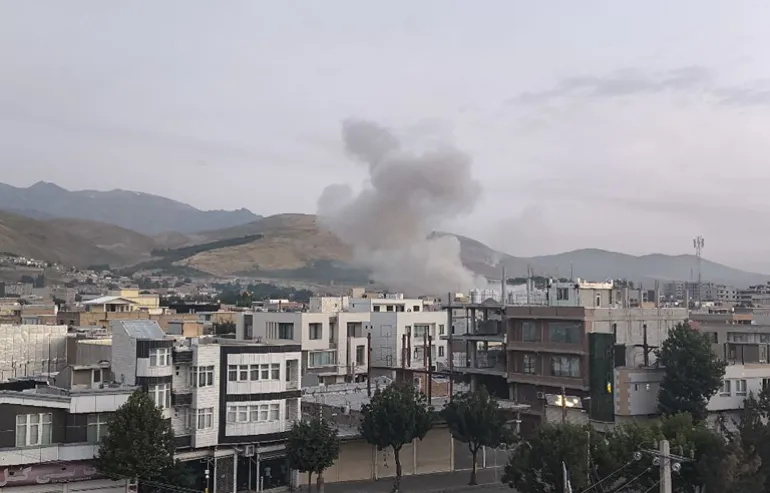- Courses
- GS Full Course 1 Year
- GS Full Course 2 Year
- GS Full Course 3 Year
- GS Full Course Till Selection
- Answer Alpha: Mains 2025 Mentorship
- MEP (Mains Enrichment Programme) Data, Facts
- Essay Target – 150+ Marks
- Online Program
- GS Recorded Course
- NCERT- First Ladder
- Polity
- Geography
- Economy
- Ancient, Medieval and Art & Culture AMAC
- Modern India, Post Independence & World History
- Environment
- Governance
- Science & Technology
- International Relations and Internal Security
- Disaster Management
- Ethics
- Current Affairs
- Indian Society and Social Issue
- CSAT
- 5 LAYERED ARJUNA Mentorship
- Public Administration Optional
- ABOUT US
- OUR TOPPERS
- TEST SERIES
- FREE STUDY MATERIAL
- VIDEOS
- CONTACT US
Africa Can Make India’s ‘Critical Mineral Mission’ Shine
Africa Can Make India’s ‘Critical Mineral Mission’ Shine
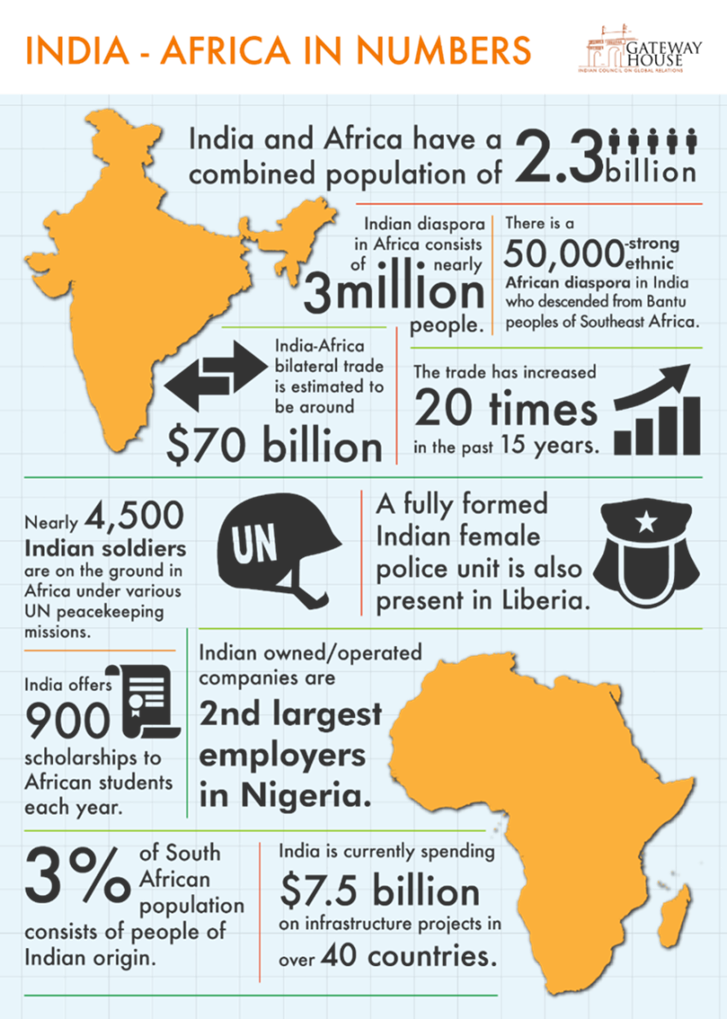
Africa is crucial to India’s strategic interests, especially in securing critical minerals essential for technological and economic progress. The continent's historical, economic, and geopolitical ties with India provide a robust foundation for collaboration. However, challenges include China’s dominance in the mineral sector and Africa’s focus on industrialization and value addition.
Significance of Africa for India:
Economic Powerhouse:
- Growth Potential: Africa’s GDP growth is projected at 4% in 2023 and 4.3% in 2024, indicating robust economic prospects.
- Trade Figures: Bilateral trade between India and Africa reached USD 98 billion in 2022-23, with USD 43 billion in the mining and mineral sectors.
- AfCFTA: The African Continental Free Trade Area (AfCFTA), effective since 2021, forms a single market of 1.3 billion people, enhancing opportunities for Indian exports and investments.
- Demographic Dividend: Africa’s population is expected to reach 2.5 billion by 2050, offering a vast market for Indian goods and services.
Geopolitical Ally:
- International Representation: Africa's 54 nations form a significant bloc in international forums, aiding India’s pursuit for a balanced global order.
- G20: The African Union (AU) was granted permanent membership in the G20 during India’s 2023 G20 Presidency.
- Strategic Balance: Strengthening India-Africa ties can counterbalance the influence of other major players, particularly China.
Energy Security:
- Oil Supply: Africa supplies about 15% of India’s oil demand (approximately 34 million tonnes), with key suppliers including Nigeria and Angola.
- Mineral Reserves: Africa’s mineral wealth is vital for India’s energy transition and technological needs.
- Solar Alliance: The International Solar Alliance, initiated by India, has allocated USD 2 billion for solar projects in Africa, benefiting both regions.
Maritime Security:
- Indian Ocean: Africa’s eastern coast is crucial for India's maritime security in the Indian Ocean Region (IOR).
- Defense Collaborations: India has signed defense agreements with Mozambique and Madagascar, and has conducted anti-piracy operations off Somalia since 2008.
- Trilateral Exercises: The India-Mozambique-Tanzania Trilateral Exercise (IMT TRILAT) enhances maritime cooperation among the Indian, Mozambican, and Tanzanian navies.
Diaspora Dynamics:
- Community Influence: The 3 million-strong Indian diaspora in Africa significantly impacts economic and cultural relations.
- Cultural Ties: Initiatives such as Pravasi Bharatiya Divas focus on strengthening ties with the Indian diaspora in Africa, enhancing bilateral relations.
Africa's Role in India’s Critical Minerals Needs:
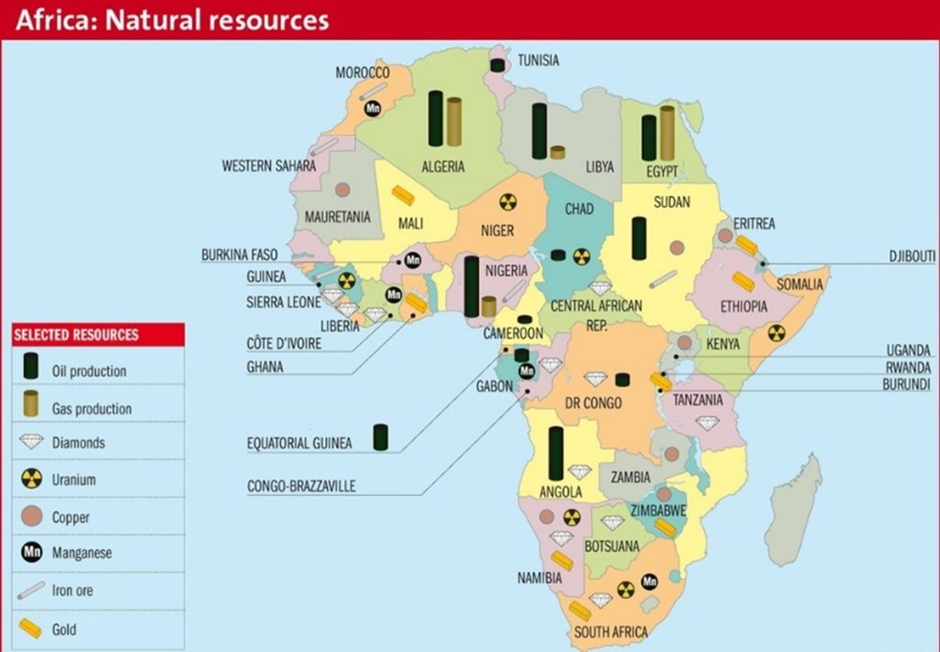
- Lithium:
- Importance: Vital for electric vehicles (EVs). Key reserves are in Zimbabwe, Namibia, and Ghana.
- Potential Impact: Securing African lithium could significantly contribute to India’s 30% EV penetration target by 2030. For example, securing 5% of Zimbabwe’s lithium reserves could power over 500,000 electric cars.
- Rare Earth Elements (REEs):
- Reserves: Africa has significant REE deposits in South Africa, Malawi, and Kenya.
- Demand: REEs are crucial for electronics and defense. For instance, an F-35 fighter jet requires 417kg of REEs.
- Platinum Group Metals (PGMs):
- Production: South Africa holds over 90% of global platinum reserves and is a major producer of palladium and rhodium.
- Usage: PGMs are essential for catalytic converters and hydrogen fuel cells, aligning with India’s push for hydrogen fuel cell vehicles.
- Copper:
- Production: Major copper producers include Zambia and the DRC.
- Requirement: India’s copper demand is projected to be 1.433 million tonnes by 2026, driven by renewable energy and EV sectors.
- Graphite:
- Sources: Madagascar and Mozambique are key producers of graphite, crucial for EV batteries and energy storage systems.
- Usage: A typical EV battery requires about 50-100 kg of graphite.
Key Areas of Friction Between India and Africa
- Investment Inertia:
- Challenges: Indian investments in Africa lag behind those of China and Western nations. Issues include risk perception, lack of local market knowledge, and competition.
- Example: In 2020, ArcelorMittal exited a USD 2.2 billion iron ore project in Senegal due to various challenges.
- Perception Issues:
- Quality Concerns: Some African markets view Indian products as inferior compared to Western or Chinese alternatives. An incident involving tainted medicine from India in Gambia in 2022 damaged India’s reputation.
- Diplomatic Dilemma:
- Regional Imbalance: India’s engagement is perceived as focused on East and Southern Africa, neglecting West Africa. For instance, India’s exports to South Africa alone totaled USD 8.47 billion in 2022-23.
- Project Execution Challenges:
- Delays: Indian development projects in Africa often face delays. The Rivatex textile factory project in Kenya experienced significant setbacks.
- Resource Rivalry:
- Competition: India faces stiff competition from China for resources in Africa, particularly in the oil and gas sectors. For example, India lost out to China in a 2006 bid for oil assets in Angola.
Measures India Can Adopt to Enhance Relations with Africa:
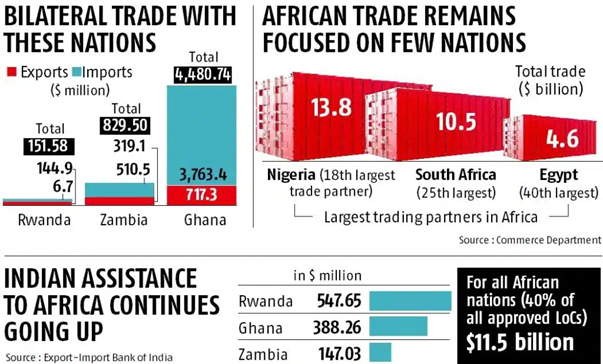
- Trade Treaty Transformation:
- Agreements: Negotiate comprehensive economic partnership agreements with key African regional blocs, such as AfCFTA.
- Tariffs: Reduce tariffs on African goods, particularly in sectors where Africa has a comparative advantage, such as agriculture and minerals.
- Skill Share Surge:
- Capacity Building: Expand and modernize capacity-building programs like the Indian Technical and Economic Cooperation (ITEC).
- Initiatives: Launch a "Digital Skills for Africa" initiative and establish IIT and IIM branches in key African countries.
- Resource Reciprocity:
- Joint Ventures: Develop strategic partnerships in critical mineral extraction with African companies.
- Development Fund: Establish an India-Africa Mineral Development Fund focusing on resources such as lithium in Zimbabwe and cobalt in the DRC.
- Infrastructure Impetus:
- Commission: Create an "India-Africa Infrastructure Commission" to oversee and expedite infrastructure projects.
- Focus Areas: Prioritize solar power installations, water treatment plants, and digital connectivity projects.
- Modernizing African Agriculture:
- Innovation Corridor: Develop an "India-Africa Agriculture Innovation Corridor" to transfer agricultural technologies and practices.
- Model Farms: Set up Indo-African model farms and launch a "Digital Farmer" app to reach 10 million African farmers with advisory and market linkage services.
Conclusion
Africa’s strategic significance for India is reinforced by its rich mineral resources, economic growth potential, and geopolitical role. To strengthen this partnership, India should focus on comprehensive trade agreements, skill development, infrastructure investment, and addressing existing frictions. Enhancing these collaborations will support India’s critical mineral needs and contribute to Africa’s development.
Must Check: Best IAS Coaching In Delhi
UPSC Prelims Result 2024 Out: Expected Cut Off & Other Details, UPSC Prelims 2024 Answer with Explanation, Daily Prelims Quiz, Daily Current Affairs, MONTHLY CURRENT AFFAIRS TOTAL (CAT) MAGAZINE, Best IAS Coaching Institute in Karol Bagh, Best IAS Coaching Institute in Delhi, Daily Mains Question Answer Practice, ENSURE IAS UPSC Toppers, UPSC Toppers Marksheet, Previous Year Interview Questions, UPSC Syllabus



